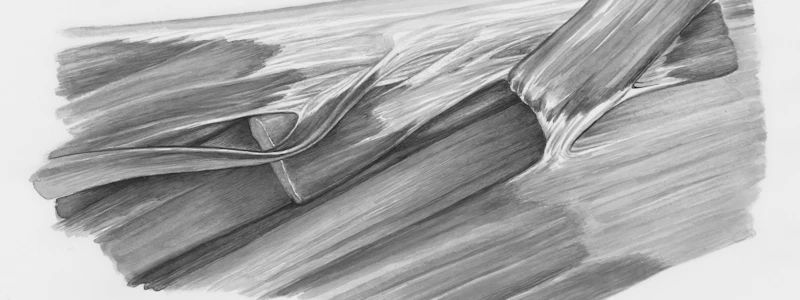Podcast
Questions and Answers
What does 'adnexa uteri' refer to?
What does 'adnexa uteri' refer to?
fallopian tubes, ovaries, and supporting ligaments
What is the amnion?
What is the amnion?
innermost membranous sac surrounding the developing fetus
What is the function of the areola?
What is the function of the areola?
dark-pigmented area surrounding the breast nipple
What are Bartholin glands?
What are Bartholin glands?
What is the cervix?
What is the cervix?
What does the chorion form?
What does the chorion form?
What is the clitoris?
What is the clitoris?
What does 'coitus' refer to?
What does 'coitus' refer to?
What is the corpus luteum?
What is the corpus luteum?
What is a cul-de-sac?
What is a cul-de-sac?
What is an embryo?
What is an embryo?
What constitutes the endometrium?
What constitutes the endometrium?
What does estrogen do?
What does estrogen do?
What is the function of the fallopian tube?
What is the function of the fallopian tube?
What is fertilization?
What is fertilization?
What is a fetus?
What is a fetus?
What are fimbriae?
What are fimbriae?
What is the function of follicle-stimulating hormone (FSH)?
What is the function of follicle-stimulating hormone (FSH)?
What is a gamete?
What is a gamete?
What does 'genitalia' refer to?
What does 'genitalia' refer to?
What is gestation?
What is gestation?
What is a gonad?
What is a gonad?
What is gynecology?
What is gynecology?
What does human chorionic gonadotropin (hCG) do?
What does human chorionic gonadotropin (hCG) do?
What is a hymen?
What is a hymen?
What are labia?
What are labia?
What do lactiferous ducts do?
What do lactiferous ducts do?
What is luteinizing hormone (LH)?
What is luteinizing hormone (LH)?
What is a mammary papilla?
What is a mammary papilla?
What is menarche?
What is menarche?
What is menopause?
What is menopause?
What is menstruation?
What is menstruation?
What is myometrium?
What is myometrium?
What does neonatology study?
What does neonatology study?
What is obstetrics?
What is obstetrics?
What is an orifice?
What is an orifice?
What is an ovarian follicle?
What is an ovarian follicle?
What is an ovary?
What is an ovary?
What is ovulation?
What is ovulation?
What is an ovum?
What is an ovum?
What is parturition?
What is parturition?
What is the perineum?
What is the perineum?
What is the pituitary gland?
What is the pituitary gland?
What is a placenta?
What is a placenta?
What is pregnancy?
What is pregnancy?
What is progesterone?
What is progesterone?
What is puberty?
What is puberty?
What is the uterine serosa?
What is the uterine serosa?
What is the uterus?
What is the uterus?
What is the vagina?
What is the vagina?
What does the vulva refer to?
What does the vulva refer to?
What is a zygote?
What is a zygote?
Flashcards are hidden until you start studying
Study Notes
Anatomy and Physiology of the Female Reproductive System
- Adnexa Uteri: Refers to fallopian tubes, ovaries, and supporting ligaments which play crucial roles in reproduction.
- Cervix: The neck-like lower part of the uterus that connects to the vagina.
- Uterus: A hollow muscular organ where embryos and fetuses develop; divided into three portions: fundus (upper), corpus (middle), and cervix (lower).
- Ovary: Almond-shaped female reproductive organ that produces egg cells and hormones, containing about 400 ovarian follicles that mature over a woman's lifetime.
Developmental Stages
- Zygote: An early prenatal stage occurring from fertilization up to 2 weeks, marking the beginning of development.
- Embryo: Stage in development from 2 to 8 weeks where basic structures form.
- Fetus: Stage from 8 weeks to approximately 40 weeks, where growth and maturation occur.
Hormones and Reproductive Functions
- Estrogen: Hormone produced by ovaries responsible for the development of female secondary sex characteristics.
- Progesterone: Secreted by the corpus luteum and placenta, essential for maintaining pregnancy.
- Human Chorionic Gonadotropin (hCG): Hormone produced by the placenta to sustain pregnancy, stimulating hormone production by the ovaries.
- Follicle-stimulating Hormone (FSH): Hormone secreted by the pituitary gland that stimulates ovarian follicle maturation.
- Luteinizing Hormone (LH): Responsible for triggering ovulation and regulating the menstrual cycle.
Key Reproductive Structures
- Fallopian Tubes: Ducts through which the ovum travels to the uterus, also known as oviducts.
- Chorion: The outermost membrane surrounding the embryo, forming part of the placenta.
- Amnion: The innermost membranous sac encasing the developing fetus, providing a protective environment.
- Cul-de-sac: A space in the lower abdomen located between the rectum and uterus, relevant in gynecological assessments.
Sexual Health and Reproductive Processes
- Coitus: Describes sexual intercourse or copulation between partners.
- Menarche: The onset of the first menstrual period, marking a female's ability to reproduce.
- Menopause: The gradual ending of menstruation, signaling the end of a female's reproductive period.
- Gestation: The duration of pregnancy, typically around 40 weeks from fertilization to birth.
- Parturition: The act of giving birth.
Other Notable Terms
- General Terminology: Includes terms like genitalia (reproductive organs), vaginal orifice (opening of the vagina), hymen (membrane covering the vagina), and perineum (area between anus and vagina).
- Gynecology: The medical study of female reproductive organs, encompassing breast health as well.
- Obstetrics: Branch of medicine focusing on the care of pregnant women, childbirth, and postpartum recovery.
- Mammary Papilla: The nipple of the breast involved in lactation.
- Lactiferous Ducts: Tubes transporting milk to the nipple.
These study notes summarize key concepts and terminology important for understanding the female reproductive system and its function in human development and reproductive health.
Studying That Suits You
Use AI to generate personalized quizzes and flashcards to suit your learning preferences.




